| Pages:
1
..
14
15
16
17
18
..
33 |
nitro-genes
International Hazard
    
Posts: 1048
Registered: 5-4-2005
Member Is Offline
|
|
Nature certainly is full of wonders 
Order of ignition, all made from recrystallized p-DDNP:
1. Acetone-evap recrystallized p-DDNP (orange/brown platelets)
2. Hydrazinium tetrazeno salt of p-DDNP
3. Potassium tetrazeno salt of p-DDNP
I just couldn't believe it, who would have thought! 
Attachment: Recrystallized p-DDNP, hydraziunium tetrazeno, potassium tetrazeno.avi (4.9MB)
This file has been downloaded 841 times
|
|
|
Rosco Bodine
Banned
Posts: 6370
Registered: 29-9-2004
Member Is Offline
Mood: analytical
|
|
Deflagration tests of the hydrazine derivatives for the p-DDNP appear substantially less energetic than the analogous derivatives of the o-DDNP. Yet
the two parent isomers seem about the same in deflagration behavior.
I have been reading the old literature and found some additional information that isopicramic acid is soluble in acids other than sulfuric such as
hydrochloric and acetic, and can be diazotized in any of them with the same p-DDNP being the result.
There are descriptions for other similar compounds which describe a scenario where diazotization is performed in a strongly acid reaction system and a
soluble diazonium salt is formed which does not precipitate but remains in solution, until the solution is greatly diluted, and then the diazonium
salt disassociates and the diazo-oxide precipitates.
Within this scheme of diazotization of a soluble precursor, it can occur for some compounds that the diazonium salt is insoluble and precipitates as a
diazonium salt rather than requiring dilution as would disassociate the diazonium salt and form and precipitate the diazo-oxide.
The energetic benzene diazonium perchlorates are of interest in this regard if any similar scheme may occur for the p-DDNP or for the o-DDNP. The
diazotization seeking the diazonium salt as the perchlorate is described as being done with the amino compound dissolved in perchloric acid. Double
decomposition might provide the low solubility diazonium perchlorate from a different soluble diazonium salt like a sulfate or hydrochloride.
I have found nothing described about any attempts or reports of experiments to see if a diazonium salt can occur for either o-DDNP or p-DDNP as a
precursor, or transient intermediate, or as a distinctly separate compound possible to isolate.
There is nothing found either about any combined isomer crystal containing both the o-DDNP and p-DDNP combined 1:1 like a distinct dl-racemic
crystalline form.
Changes in crystalline form can produce anomalies like density changes and different explosive properties. Whether that occurs for the o-DDNP and
p-DDNP is unknown.
It is also possible and worth a look to see if the undiazotized precursor amino acids, which form soluble sulfates or other soluble acid salts, may
form a low solubility perchlorate salt which would very probably be energetic.
[Edited on 1-6-2015 by Rosco Bodine]
|
|
|
Rosco Bodine
Banned
Posts: 6370
Registered: 29-9-2004
Member Is Offline
Mood: analytical
|
|
Earlier it was speculated that the p-DDNP (or some of the derivatives) could have usefulness as a component of a triple base gunpowder. Another idea
is the possible usefulness as a propellant useful in small caliber caseless ammunition as a modernized variant of the Flobert Ammunition concept.
The idea is that a small caliber hollow base bullet generally following the concept of a miniature Minie ball, made something like a skirted shotgun
slug would have within the hollow space formed a conical spindle centered on the axis so that it would be like a stalagtite hanging down from the
center of the roof of the cavity with its lower tip almost but short of the length of the skirt.
The idea is if the the bullet was resting on its hollow bottom on a flat surface with the nose end vertical, the end of the "stalagtite" within the
hollow base chamber would have a slight gap to not quite touch the surface. This gap formed into the hollow base axis is a deliberately formed "spark
gap" which will be the ignition means, and will align with a "firing pin" that is a pointed electrode "needle" carried in the face of the bolt which
closes the "chamber" and pierces the combustible nitrocellulose film covering the base of the bullet, to space proper distance for the spark gap to
enable firing by piezoelectric or electronic ignition when the trigger is pulled to fire the round.
In the alternative, there could be anchored into the axis of the hollow chamber one end of a stiff but small gauge bridgewire whisker, which would
extend through the nitrocellulose film seal, with the free end of that bridge wire making electrical contact with a conductive surface in the center
of the face of the bolt, to be fired as a conventional electrical squib. An alloy could be chosen for the bridgewire that would be vaporized during
firing so that no significant residues or fouling would result.
A caseless ammunition of small caliber, perhaps .20 cal or 5mm is contemplated. The propellant would be in part or in whole p-DDNP and the base of
the caseless ammunition would be sealed off with a combustible nitrocellulose film. This sealing film would be punctured by the electrode "firing
pin" when the bolt is closed or as a mechanical step of the electrical firing sequence itself. Depending upon the propellant loading weight and
composition, and caliber of the design, the velocity and performance could be made whatever is desired, ranging from something tame like an air rifle
to something more comparable to a conventional firearm.
[Edited on 2-6-2015 by Rosco Bodine]
|
|
|
Rosco Bodine
Banned
Posts: 6370
Registered: 29-9-2004
Member Is Offline
Mood: analytical
|
|
Thanks to solo for the attached reference.
Our friends in Munich have been looking at p-DDNP but have used a more difficult synthetic route than isopicramic acid which is the more direct route
we have been discussing here.
The synthetic method involving direct nitration of paracetamol to form acetylisopicramic acid followed by deacetylation and diazotization is IMO a
simpler and better route to p-DDNP.
Even so, there has been done some testing which shows decreased friction sensitivity and confirms increased temperature stability for p-DDNP compared
with o-DDNP while impact sensitivity is about equal.
Density difference for p-DDNP and theoretical power calculations predict a 5% greater detonation pressure and velocity for p-DDNP compared with
o-DDNP, so the theoretical analysis predicts better performance as an initiator, but actual testing is yet to be done.
It looks like we are very probably onto something new (novel invention) with these experiments involving p-DDNP 
p-DDNP has definite potential usefulness as a green energetic.
Edit: I have reduced the file size for the attached article
Attachment: Synthesis & Energetic Properties of 4-Diazo-2,6-dinitrophenol and 6-Diazo-3-hydroxy-2,4-dinitrophenol.pdf (286kB)
This file has been downloaded 1164 times
In the article compound [4] is p-DDNP
In the article compound [5] is acetylated paracetamol corresponding with the diacetylaminophenol of Reverdin and Meldola
excerpt from the article:
| Quote: |
Energetic properties of compounds 4 and 8 in comparison
to DDNP are displayed in Table 1. The impact sensitivity
of all three compounds is 1 J, typically for primary explosives.
Therefore handling of these compounds should be
carried out only with proper safety measures! Interestingly,
compounds 4 and 8 are also very sensitive toward friction but slightly less than DDNP, what makes them safer for
handling. In addition they are slightly better (ca. 10–12 °C)
in thermal stability. Due to the higher densities of 4 and 8 in
comparison to DDNP higher detonation parameters were
calculated by using the EXPLO5 V6.01 computer code. Statistically, detonation pressure and velocity of 4 and 8 are
ca. 5% higher than those of DDNP. An empirical confirmation
of these values has to be further researched in order
to determine the relevance, as well as the benefits of those
compounds. For selected applications like initiation of secondary
explosives, these advantages could surpass the detriment
of an increased number of synthetic steps to produce
4 and 8. |
I would point out that the detriment being noted regarding an increased number of synthetic steps is a disadvantage only in consideration for the
synthetic approach described as the method used by our friends in Munich to produce the sample of p-DDNP for their testing.
There is a much simpler synthetic pathway to p-DDNP via isopicramic acid. And the simple dinitration of paracetamol followed by deacetylation via
simple hydrolysis, all done under mild conditions, is a synthetic pathway comparable in simplicity and economics with the analogous means of producing
o-DDNP via picramic acid. For commercial manufacture, the pathway to p-DDNP may be simpler and more economical than the pathway to o-DDNP, based upon
the costs of raw materials and synthetic steps likely to be employed for mass production.
For historical interest I should attach here the original article identifying isopicramic acid obtained from nitration of para benzoylaminophenol
described by Dabney in December 1882.
Later it has been found that the acetyl derivative paracetamol is a more convenient precursor which also works very well for dinitration forming an
intermediate dinitroacetaminophenol, the acetyl analogue of the benzoyl derivative described by Dabney, which similarly upon hydrolysis yields the
same isopicramic acid. Diazotization produces p-DDNP.
Attachment: Pages from American_Chemical_Journal 1884 Volume 5 Dabney pg 20 to 38.pdf (458kB)
This file has been downloaded 639 times
[Edited on 6/12/2015 by Rosco Bodine]
|
|
|
nitro-genes
International Hazard
    
Posts: 1048
Registered: 5-4-2005
Member Is Offline
|
|
Jesus, this paper is from June this year, coincidence?!
Thanks for looking up that reference Rosco and Solo! Holy shit, I knew it, compound 6 exists and is reasonably stable, though obtained only in
moderate yields. The possibilities in combination with the Japan paper... ...headache...need more acetaminophen. Could be compounds 7 and 8 are actually impurities in the p-DDNP from paracetamol. Does make me wonder what
would happen if 3 mole eqv of AN are used for the nitration. ...headache...need more acetaminophen. Could be compounds 7 and 8 are actually impurities in the p-DDNP from paracetamol. Does make me wonder what
would happen if 3 mole eqv of AN are used for the nitration.
And true, route from acetaminophen would be better to scale up, extra benefit seems that there are no high explosive intermediates in the synthesis of
isopicramic, like for picramic from picric acid for o-DDNP. There is one thing I still want to look into. It occured strange to me that the p-DDNP
tetrazeno derivatives are so much less energetic than it's o-DDNP cousins. There also seems more N2 gas produced when reacted with hydrazine. Since
DDNP is destroyed very fast by OH-, and p-DDNP tetrazeno derivatives resemble the parent isopicramate salts, either the ortho position is nesseccary
for the tetrazeno formation...or...p-DDNP is MUCH more sensitive to destruction by a base, which would mean potential problems with moisture at long
term storage. Haven't seen any references in which that was tested.
[Edited on 12-6-2015 by nitro-genes]
|
|
|
Rosco Bodine
Banned
Posts: 6370
Registered: 29-9-2004
Member Is Offline
Mood: analytical
|
|
The use of the (monoacetyl) paracetamol for the nitration performed as we have discussed will not lead to any further nitration beyond the dinitro
stage. Meldola has established this, by failed attempts to aggressively nitrate further the dinitroparacetamol. A different order of entering nitro
groups by a different approach to nitration is required for a third entering nitro to be possible. So no worries about over nitration of the
paracetamol. Only the dinitrate or oxidation products will be produced.
There is still a curiosity about the cocrystallization of the o-DDNP with p-DDNP which could form a mixed isomer having properties that may differ
from either isomer alone. Likely any difference would be trivial, but that is not assured.
Plenty of room for experiments with p-DDNP since we seem to have resurrected a compound that is pretty much a ghost for its obscurity.
[Edited on 6/12/2015 by Rosco Bodine]
|
|
|
nitro-genes
International Hazard
    
Posts: 1048
Registered: 5-4-2005
Member Is Offline
|
|
Yeah, you're right, forgot... They probably obtained the trinitro derivative though NO from desructive oxidation of part of the product, similar to
diazotization of picramic using HNO3,explaining reported moderate yields. Possibly, yield can be improved by performing nitrite nitration under
neutral conditions via viscinal acetmino group (japan paper) and then nitration. Curious what the product of compound 7 would be after refluxing with
hydrazine and then using 3 mole eqv of nitrite... Long shot maybe, but could this possibly produce the first benzene structure bearing both a nitro,
triazole (N-oxide?) and diazo group in one?! 
[Edited on 13-6-2015 by nitro-genes]
|
|
|
Rosco Bodine
Banned
Posts: 6370
Registered: 29-9-2004
Member Is Offline
Mood: analytical
|
|
The diacetyl derivative is the starting point for the trinitro derivative. But there are stability issues. You would have to further acetylate the
phenol on the ring of paracetamol which is a monoacetyl (N-acetyl) and the nitration method differs.
You can't add the diacetyl to sulfuric acid which splits off the acetyl from the OH and reverts the substrate being nitrated right back to
paracetamol.
See the articles attached here
http://www.sciencemadness.org/talk/viewthread.php?tid=28533&...
I haven't compared the syntheses carefully yet but there could be a 2,3,5 trinitro compound there for [7] instead of the 2,3,6 as it is being
identified.
See the early publication page for this work in progress
http://onlinelibrary.wiley.com/doi/10.1002/ejoc.201500465/ab...
Edit: I just noticed that in the abstract for the article, compound [7] is identified as the 2,3,5 trinitro but in the article itself is identified as
the 2,3,6 trinitro .....so it evidently is a misprint, or typo, or else it is still being sorted out ......in which case they have my sympathy  May I recommend the ancient literature, for clarification May I recommend the ancient literature, for clarification 
I really hate the convoluted IUPAC nomenclature convention usage and having to translate it back to what seems the more simple and eloquent
nomenclature of the past. This is confusing enough to follow without the fashionable new names for phenol derivatives which dare to not assign ring
position 1 for the hydroxyl of phenol derivatives if they can be called a hydroxylated alternative compound as semantics.
p-acetaminophenol or N-acetyl-4-amino-phenol became the IUPAC convention named N-(4-hydroxyphenyl)acetamide.
In my humble opinion such new naming is pure garbage semantics that is change for the sake of change, not clarity.
I don't like the inverted ring diagrams either that place ring position 1 of phenol at 6 o'clock instead of 12 o'clock. I understand it is
conventional for the reaction scheme shown for the halogenated benzoic acid starting material and for the aniline derivative intermediate, but why use
a long way around more difficult synthetic route for the p-DDNP is something not understood. It seems to be an overly complicated synthetic path that
is just not necessary nor good economy. As our friend PHILOU Zrealone would likely say, to kill a fly you can use a fly swatter or a small amount of
pyrethrin or a nuclear weapon, and all will kill the fly equally dead, but the lesser complex approach may serve better the intended purpose.
Last but not least, the computer predictions on energy for the experimental compounds are interesting theoretical analyses. However, I think there may
occur test result evidences which may show those models may need revision. How good are the models remains to be seen. Certainly this provides a good
opportunity to test the models and see their worth.
[Edited on 6/13/2015 by Rosco Bodine]
|
|
|
nitro-genes
International Hazard
    
Posts: 1048
Registered: 5-4-2005
Member Is Offline
|
|
The Dabney paper was a nice read, thanks.  "subjecting the solution to a winters
cold"...doesn't that sound much better than "the solution was shoved in a freezer". Have to remember this sentence for future papers. Also thought
about a route from salicylic acid, TCCA may be used to chlorinate the salicylic acid in 5 position (relative to acid group, p relative to OH). Most
likely, only one chloro group would be added and since the chlorination presumably goes via an intermediate TCCA-phenyl complex, it would only produce
the para derivative, as opposed to chlorination using nascent chlorine. TCCA gives no chlorinated products with benzoic acid, but salicylic acid was
not tested in the paper that was posted on SMDB. Also not sure how 5-chloro salicylic acid would behave under strong nitrating conditions. "subjecting the solution to a winters
cold"...doesn't that sound much better than "the solution was shoved in a freezer". Have to remember this sentence for future papers. Also thought
about a route from salicylic acid, TCCA may be used to chlorinate the salicylic acid in 5 position (relative to acid group, p relative to OH). Most
likely, only one chloro group would be added and since the chlorination presumably goes via an intermediate TCCA-phenyl complex, it would only produce
the para derivative, as opposed to chlorination using nascent chlorine. TCCA gives no chlorinated products with benzoic acid, but salicylic acid was
not tested in the paper that was posted on SMDB. Also not sure how 5-chloro salicylic acid would behave under strong nitrating conditions.
Also interesting from the Dabney paper: It seems that iso picramic can be recrystallized from water very well, this is something I will try somewhere
in the future. They also mention surface oxidation of the isopicramic acid, wondered about this as well and kept it in an airtight container. Wouldn't
this be a major drawback for the synthesis of p-DDNP on a larger scale?
|
|
|
Rosco Bodine
Banned
Posts: 6370
Registered: 29-9-2004
Member Is Offline
Mood: analytical
|
|
I understand what you mean, the 5 position of salicylic acid becomes after decarboxylation to phenol the 4 position of phenol.
When derivatives of phenol are described using older "classical" conventional nomenclature with the hydroxyl of phenol being assigned ring position
1, the group para (to 1 of phenol) is always ring position 4, and meta would be 3 or 5, and ortho would be 2 or 6.
Position 1 is at 12 o'clock and the numbers increase clockwise by two hour intervals describing a hexagon on a clock face.
When I see later IUPAC naming it sometimes grates my nerves when it seems the long way around to avoid a trivial name. I suppose it helps avoid
having 5 or 6 different names for the same compound unless of course the IUPAC name is already number 5 or 6 added to the existing list of AKA's.
Dabney provides some interesting description of decarboxylation of the nitrosalicylic acid as a split reaction during higher nitration that provides
some insight into the discussion about production of picric acid where there was some disagreement about at what stage occurred the decarboxylation.
It would seem likely that we were both right, and that half of the decarboxylation occurs early in the nitration and half subsequently, when the
sulfonated derivative of aspirin is being nitrated to picric acid.
That would tend to make the decarboxylation indefinite as occurring at any particular step in the nitration, as it would be an ongoing process
evolving CO2 over at least two stages of the nitration which overlap, likely also true for the nitrations of sulfonated aspirin that lead to picric
acid.
I don't see any significant problem with superficial oxidation for isopicramic acid even if it is actual oxidation, which it may not be. Sometimes
wet crystals are reflective but dried they are dull simply because of of surface roughness.
Quote: Originally posted by nitro-genes  | Jesus, this paper is from June this year, coincidence?!
Thanks for looking up that reference Rosco and Solo! Holy shit, I knew it, compound 6 exists and is reasonably stable, though obtained only in
moderate yields. The possibilities in combination with the Japan paper... ...headache...need more acetaminophen. ...headache...need more acetaminophen. |
Actually we have been poking around about p-DDNP for a year now since June of last year, so the discussion was bound to get noticed sooner or later

That bottle of paracetamol quietly hides chemical history and mystery like a genie in a bottle awaiting a rub from Japanese or German chemist alike,
to send them back to school and test their mettle and ask the question "What do you really know about organic chemistry?" 
Rumor has it the only sure headache cure is more accordion music and more beer  It is like musical chairs around the benzene ring .......the music stops and there you are!
It is like musical chairs around the benzene ring .......the music stops and there you are! 
It will require reviewing the literature but on preliminary reading it seems possible there could be structural identification issues in the early
online version of the article. For [7} that is obvious as an issue, with contradiction in the abstract and maybe a typo, but [6] also definitely
needs review, and I will look at [8] some more too. On first glance they seem worth a closer look to double check those structures. Frankly I am
dubious about the instrumental analysis and would prefer old school proof of structure.
Klapotke may have to hire a psychic to channel the ghosts of Reverdin and Meldola  I didn't notice their names credited in the references and that is possibly an omission, unless they are included and superseded by some of the later
references. There was some passing commentary in articles by Meldola not providing complete details for understanding variations on nitrations, which
would possibly be covered in more detail in the book written by Meldola about his experiments.
I didn't notice their names credited in the references and that is possibly an omission, unless they are included and superseded by some of the later
references. There was some passing commentary in articles by Meldola not providing complete details for understanding variations on nitrations, which
would possibly be covered in more detail in the book written by Meldola about his experiments.
[Edited on 6/13/2015 by Rosco Bodine]
|
|
|
Rosco Bodine
Banned
Posts: 6370
Registered: 29-9-2004
Member Is Offline
Mood: analytical
|
|
After referencing the literature and reviewing the reactions described in the Klapotke article I found that the Abstract description as the 2,3,5
trinitro for compound [7] is indeed a typo, and the article description identifying compound [7] as the 2,3,6 trinitro is correct. Melting point with
decomposition at 119C also identifies the 2,3,6 trinitro as distinct from the 2,3,5 mp 145C.
Likewise the article descriptions for compound [6] appears correct.
Compound [8} is also correct and is interesting. It appears likely there is an unstable and soluble diazonium salt intermediate which decomposes on
dilution to form the diazo phenol. Compound [8] may also form salts which could be interesting.
If I get a headache from looking too much at all these structures, I'll probably have to dig into my economy size bottle of acetaminophen. 
There has occurred an overlap once again with the other thread, with regards to further usefulness of paracetamol as a precursor. See the following
post for references, of interest.
http://www.sciencemadness.org/talk/viewthread.php?tid=62204&...
For convenience I will attach the most pertinent reference here
The alternative approach to nitration of paracetamol to form 3-nitro-4-acetamidophenol provides a high yield of the precursor for nitration to produce
the 2,3,5 trinitro derivatives, including a diazo-oxide which retains all 3 nitro groups, or may be easily converted by boiling in alcohol to a
dinitrohydroxyquinone diazide which forms salts, and is isomeric with compound [8] of the Klapotke article.
Also made accessible by the 2,3-dinitro-4-acetamidophenol, after deacetylation is a second variant isomeric p-DDNP that is the
4-diazo-2,3-dinitrophenol which is distinct from the 4-diazo-2,6-dinitrophenol derived from the isopicramic acid of Dabney.
There exists both an Alpha p-DDNP as we have been discussing, but also there is a Beta p-DDNP possible.
So several energetic materials, at least 4 different diazo compounds are obtainable from paracetamol without requiring its higher acetylation to
paracetamol acetate.
The p-DDNP from isopicramic acid is 1 of the 4 identified.
It is likely the safest and most stable of the 4.
Attachment: A NEW NITRATION PRODUCT, 3-NITRO-4-ACETAMIDOPHENOL, OBTAINED FROM ACETAMINOPHEN WITH NITROUS ACID.pdf (178kB)
This file has been downloaded 459 times
Attachment: article Meldola and Hay JCS Vol95 pg1378.pdf (1MB)
This file has been downloaded 552 times
Attachment: Pages from Journal_of_the_Chemical_Society pg1935.pdf (423kB)
This file has been downloaded 567 times
[Edited on 6/15/2015 by Rosco Bodine]
|
|
|
Rosco Bodine
Banned
Posts: 6370
Registered: 29-9-2004
Member Is Offline
Mood: analytical
|
|
The 1989 Chemical and Pharmaceutical Bulletin article attached above for producing 3-nitro-4-acetamidophenol in 81% yield from paracetamol is most
interesting because it makes possible the use of the more convenient N-monoacetyl compound that is paracetamol by way of conversion to
3-nitro-4-acetamidophenol, to avoid the requirement of the diacetyl compound, ( paracetamol acetate ) as a precursor which may be nitrated to the
trinitro compounds.
It is already established that direct nitration of paracetamol by several different nitration schemes will lead only to the 2,6-dinitro compound which
is acetyl-isopicramic acid.
However, if a different approach to an alternative nitrite nitration scheme is applied to paracetamol to produce 3-nitro-4-acetamidophenol, this makes
possible further nitration to the trinitro derivatives and also makes accessible the 2,3-dinitro derivatives. It is clear that the 2,3,5 trinitro
derivatives are accessible via the further nitration of 3-nitro-4-acetamidophenol.
Also interesting, is it seems likely that the 2,3,6 trinitro derivatives may be produced, based upon this interesting footnote in the Meldola and
Reverdin article on journal page 1492. If I understand clearly this information, use of a sulfuric and nitric acid mixture for further nitration of
3-nitro-4-acetamidophenol leads to the 2,3,6-trinitro-4-acetylaminopehnol which is the compound [6] of the Klapotke article, by a different synthetic
route requiring no acetic anhydride for producing a diacetyl precursor for nitration.
Note: The IUPAC nomenclature for compound [6] is N-(4-Hydroxy-3,5,6-trinitrophenyl)acetamide
This is synonymous with older nomenclature that is 4-acetamido-2,3,6-trinitrophenol or
2,3,6-trinitro-4-acetylaminophenol or
2,3,6-trinitro-p-acetylaminophenol
By using different nitration schemes, applied to 3-nitro-4-acetamidophenol produced easily in high yield from ordinary paracetamol, it appears
sulfuric acid mixed with nitric acid will lead to the 2,3,6-trinitro derivatives, while in the alternative the 2,3,5-trinitro compounds will be
produced by nitrations of
3-nitro-4-acetamidophenol using nitric acid or nitric acid mixed with acetic acid, in which sulfuric acid is not contained.
If my understanding of the footnote is correct, the presence or absence of sulfuric acid in the nitration mixture applied to 3-nitro-4-acetamidophenol
will determine which isomer trinitro compound is produced. With sulfuric acid present in the nitration mixture the 2,3,6-trinitro-4-acetylaminophenol
is the result. Absent sulfuric acid in the nitration mixture for 3-nitro-4-acetamidophenol, then 2,3,5-trinitro-4-acetylaminophenol is the result.
This would need to be confirmed by experiment, testing the melting points for the deacetylated products, the 2,3,6-trinitro-4-aminophenol mp 117-120C
and for the 2,3,5-trinitro mp reported 145C with decomposition.
Thus far nothing found in the literature sheds further light on this possible selectivity for the trinitro isomer produced.
Aside from the diazo derivatives that are possible, of particular interest is the reported reactivity with hydrazine for the trinitro compounds, and
what may be the results of subsequent derivatives possible for such hydrazides. An assortment of potential green energetics could be possible.
I, or we, welcome any commentary or feedback on any of this subject material from our readers in Munich. A penny for your thoughts  These synthetic approaches using ordinary and cheap paracetamol provide more direct
and economical paths to not only the compounds [4], [6], [7], [8], as described in the Klapotke article, but to a portfolio of similar related
compounds which have potential usefulness as green energetics. These synthetic approaches using ordinary and cheap paracetamol provide more direct
and economical paths to not only the compounds [4], [6], [7], [8], as described in the Klapotke article, but to a portfolio of similar related
compounds which have potential usefulness as green energetics.
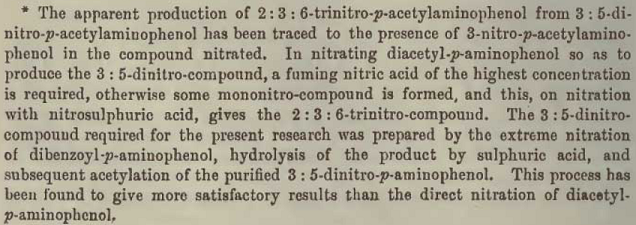
Thanks to solo for article attached providing helpful data for 2,3,5 trinitro compound further identification by salts
Attachment: Salts and Ethers of 2-3-5-trinitro-4-acetyl-aminophenol-Meldola 1910.pdf (840kB)
This file has been downloaded 510 times
[Edited on 6/15/2015 by Rosco Bodine]
|
|
|
nitro-genes
International Hazard
    
Posts: 1048
Registered: 5-4-2005
Member Is Offline
|
|
Nice overview of references Rosco.  As for the possible mechanism for SA
selectivity for the 2,6 trinitro; could a contributing factor be the steric hinderance of the sulfate group due to formation of the isopicramic
sulfate? Water content, oxidation f product and reduction of NA to HNO2? As for the possible mechanism for SA
selectivity for the 2,6 trinitro; could a contributing factor be the steric hinderance of the sulfate group due to formation of the isopicramic
sulfate? Water content, oxidation f product and reduction of NA to HNO2?
[Edited on 16-6-2015 by nitro-genes]
|
|
|
Rosco Bodine
Banned
Posts: 6370
Registered: 29-9-2004
Member Is Offline
Mood: analytical
|
|
Hold the phone on the distinction between the 2,3,5 and 2,3,6 compounds as have been showing in the literature. When I began this research about a
year ago I expressed skepticism about some of the structural identifications and surmised some confusion and uncertainty about some of the writings
and such skepticism has been borne out as justified.
Evidently some or all of the structures identified as 2,3,5 trinitro may actually be 2,3,6 trinitro.
Here is the link for the paper. It appears that Meldola and Reverdin went around in circles on this.
There was also what amounts to an errata declaration made by Meldola AND Reverdin in Proceedings (Royal Chemical Society) 1912 for which I have made a
screenshot. So it looks like they were not in disagreement but were joined in error discovered later. And it does appear the other work apart from
the structural confusion remains valid.
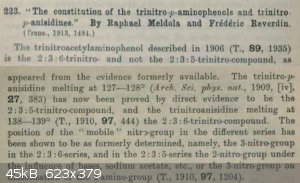
Some of my earlier analyses will need revision with regards to 2,3,5 trinitro structures which were misidentified probably by Meldola. I am still
sorting this out. I think the reactions described and data are probably correct other than the early researchers confusion about structure.
I recall mentioning Federoff shared my skepticism and referred to the authors writings about what they called a trinitro 2,3,5 compound , yet Federoff
called it a 2,3,6 trinitro in PATR essentially correcting the authors  See
PATR Vol. 2 pg B-60 See
PATR Vol. 2 pg B-60
http://pubs.rsc.org/en/content/articlelanding/1914/ct/ct9140...
Thanks to solo for the attached article
Attachment: Meldola and Hollely, JCS 1914, 105, 977 to 990.pdf (884kB)
This file has been downloaded 512 times
From what I can make of this discrepancy about structure, there is disagreement between Meldola and Reverdin and Meldola is "surrendering" to the
views of Reverdin and
basically "leaving the matter in the capable hands of Reverdin" as an unfinished business.
I tend to believe the synthetic procedures and analyses and measurements and observations have validity, but for the theoretical aspects about
structural identification of the differing isomers there was not a meeting of the minds for Meldola and Reverdin. The work at synthesis done aside
from the ambiguity about structural identity still has validity and since there are only two possible isomers for the trinitro compounds of
p-aminophenol it is like a coin toss and a guess if the sample compound is the 2,3,6 trinitro or the 2,3,5 trinitro. There could be mixed isomers of
course. But these chemists were not novices and should know when they have isolated pure compounds, even if there was disagreement about that sample
being one isomer or the other.
It could be sorted out on a case by case basis what is the result produced by a synthesis even if no definite general rules can be established for
predicting exactly what isomer should be produced.
I would have to laugh if my speculation above about the presence or absence of sulfuric acid did turn out to be the variable which predicts the isomer
that will result. It was a reasonable conclusion assuming the information being reported was accurate. Did I see something simple hiding before them
in plain view which they somehow overlooked?
Hmmm now there's an idea.
It appears there was study of these compounds for 10 years without conclusive results about positively identifying the two isomers, if Meldola is
understood. So if you make the trinitro compounds then it is probably the 2,3,6 but not certain.
Hopefully the observations not related to identifying the isomer correctly are still valid.
And hopefully some of the more modern references have provided clarification about the isomers and what determines which isomer or if a mixture is
produced.
[Edited on 6/16/2015 by Rosco Bodine]
|
|
|
Hennig Brand
International Hazard
    
Posts: 1284
Registered: 7-6-2009
Member Is Offline
Mood: No Mood
|
|
Iso-Picramic Acid Synthesis
Well I have what I hope is iso-picramic acid. It has been drying for the last day or so, so I will include a picture of the dry yield and attempt to
make some iso-DDNP using it.
Extraction of Paracetamol (acetaminophen)
Forty extra strength 500mg Tylenol tablets were put into a Mason jar and an amount of methanol was added which was at least the height of the pills
over and above the pills (very scientific measurement  ). An oval stir bar was
added and the mixture was stirred using magnetic stirring at room temperature until dissolution and erosion caused the pills to break up. The stirring
was ceased and the mixture allowed to settle for several hours before pipetting off the clear paracetamol in methanol upper layer. More methanol was
added to the pill residue and it was again stirred up and left to settle before removing more solution. This could have been done at least once more,
but it wasn't. The combined methanol solution was next heated, below the boil with stirring, until most of the methanol was gone before adding 30-40mL
of cold water (the remaining methanol could have easily been evaporated, but the water may have served a function over and above reducing solubility,
it may have dissolved some of the trace amounts of water soluble impurities from the pills which made it through the extraction. ). An oval stir bar was
added and the mixture was stirred using magnetic stirring at room temperature until dissolution and erosion caused the pills to break up. The stirring
was ceased and the mixture allowed to settle for several hours before pipetting off the clear paracetamol in methanol upper layer. More methanol was
added to the pill residue and it was again stirred up and left to settle before removing more solution. This could have been done at least once more,
but it wasn't. The combined methanol solution was next heated, below the boil with stirring, until most of the methanol was gone before adding 30-40mL
of cold water (the remaining methanol could have easily been evaporated, but the water may have served a function over and above reducing solubility,
it may have dissolved some of the trace amounts of water soluble impurities from the pills which made it through the extraction.
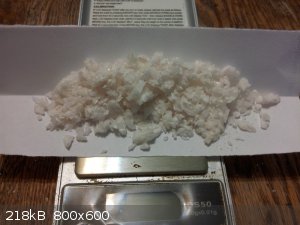
Dinitration of Acetaminophenol
Nitro-Genes posts were used as a general guide. The following numbers were used which were suggested by Rosco:
"
[A] For each 1 gram of paracetamol to be dinitrated, dissolve in 4 ml H2SO4
[B] For each gram of paracetamol to be dinitrated, use 1.4 gram of NH4NO3 mixed with 1.5 ml H2SO4
Add gradually with stirring B to A maintaining about 5C
The quench / dilution mixture should have about 15 grams ice for each gram of paracetamol.
It would possibly benefit the nitration mixture to sit for a couple of hours in the ice bath with continued stirring before quenching."
I used the following method because I was lazy, busy and very low on ice. 14.4g of paracetamol was started with and 91% sulfuric acid was used
throughout. The powdered paracetamol was added to the sulfuric acid in a Mason jar in about six increments with swirling and in between additions the
solution was cooled down in the fridge. The ammonium nitrate (fertilizer grade recrystallized from water) was added to sulfuric acid in another Mason
jar and left to dissolve over night in the dark at room temperature. The paracetamol in sulfuric acid was kept in the fridge while the nitration
mixture was not, though they both probably could have been. A large oval stirrbar was added to the vessel holding the solution of paracetomol in
sulfuric acid. When making an addition about 3-5mL of the nitration mixture was added with swirling before placing the mixture back into the fridge to
cool. Starting the nitration in the morning I made additions randomly, about once an hour. By early afternoon the additions were complete. It wasn't
until the next morning that the nitration mixture was removed from the fridge and quenched with crushed ice and filtered and rinsed with water.
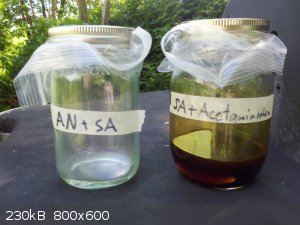 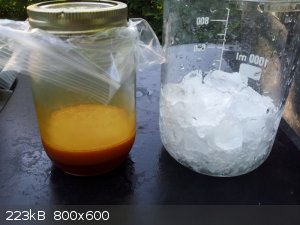 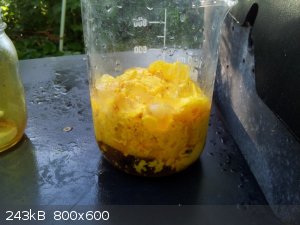 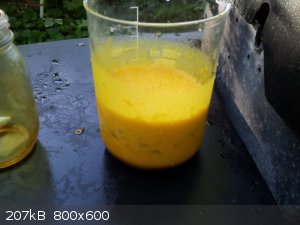 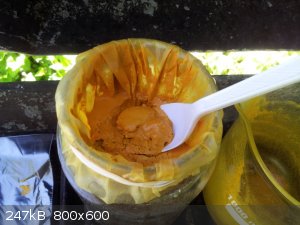
De-acetylation to Iso-Picramic Acid
About 15mL of 91% sulfuric acid and 15mL of water were mixed and added to the still damp dinitro acetaminophenol in a beaker with stirrbar. The
temperature was raised gradually and at about 70C the smell of acetic acid was very noticeable and by 80C the fumes were very strong, almost choking.
After about 45 minutes and with the temperature at 100-105C no more smell of acetic acid could be detected. The color change from light to dark
occurred mostly in the first 10 minutes or so of heating. About 80mL of water was then added. Filtration was attempted but was then aborted, as a
test, but also because not everything was in solution (does it matter?). The amount of acid and water used was likely not ideal.
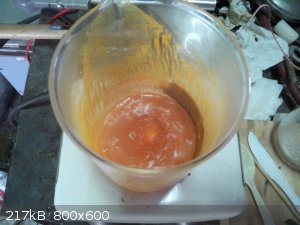 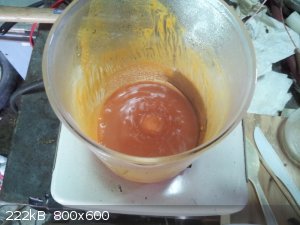 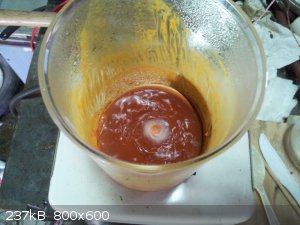 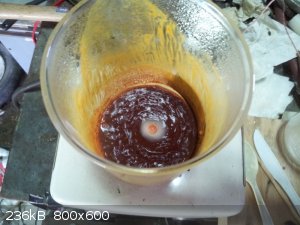 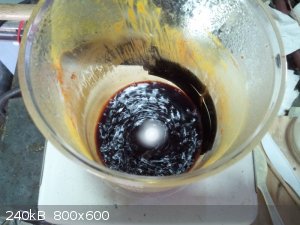 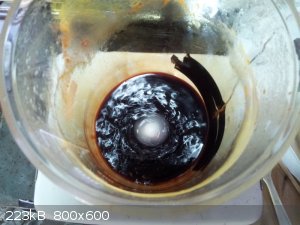
The solution was next allowed to cool and then household ammonia was pipetted in with stirring unit the color change to red became apparent and then a
couple drops of 31.45% HCl was added to bring the pH back down slightly (I was going to use sulfuric acid, but the HCl was much closer to me at the
time and it was just a couple of drops). The reddish brown iso-picramic acid was easily gravity filtered. The yield is now nearly dry. I will post a
picture of the dry yield soon and will attempt diazotisation to iso-DDNP. There were many transfer losses, etc, so the yield may not be great.
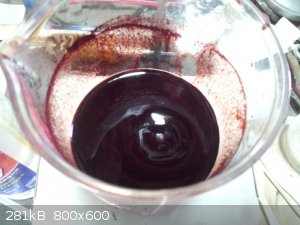 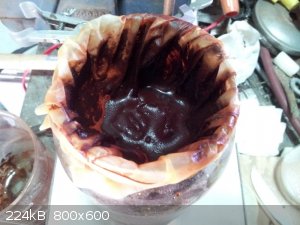
[Edited on 16-6-2015 by Hennig Brand]
"A risk-free world is a very dull world, one from which we are apt to learn little of consequence." -Geerat Vermeij
|
|
|
Rosco Bodine
Banned
Posts: 6370
Registered: 29-9-2004
Member Is Offline
Mood: analytical
|
|
Quote: Originally posted by Hennig Brand  |
De-acetylation to Iso-Picramic Acid
About 15mL of 91% sulfuric acid and 15mL of water were mixed and added to the still damp dinitro acetaminophenol in a beaker with stirrbar. The
temperature was raised gradually and at about 70C the smell of acetic acid was very noticeable and by 80C the fumes were very strong, almost choking.
After about 45 minutes and with the temperature at 100-105C no more smell of acetic acid could be detected. The color change from light to dark
occurred mostly in the first 10 minutes or so of heating.
About 80mL of water was then added. Filtration was attempted but was then aborted, as a test, but also because not everything was in solution (does it
matter?). The amount of acid and water used was likely not ideal. |
Yes, it does matter that everything is not in solution.
Here at this stage the deacetylation of the acetylisopicramic acid using H2SO4 is going to produce the soluble sulfate of isopicramic acid, if
sufficient liquid phase is present and whatever a filtering would trap would be impurities that are not the soluble isopicramic acid sulfate which
should pass right through the filter. Your filtered liquid phase containing dissolved isopicramic acid sulfate is then neutralized of its mineral
acid component to disrupt the soluble sulfate and precipitate the free isopicramic acid. Then filtering, the filter catches the nearly insoluble
isopicramic acid.
| Quote: |
The solution was next allowed to cool and then household ammonia was pipetted in with stirring unit the color change to red became apparent and then a
couple drops of 31.45% HCl was added to bring the pH back down slightly (I was going to use sulfuric acid, but the HCl was much closer to me at the
time and it was just a couple of drops). The reddish brown iso-picramic acid was easily gravity filtered. The yield is now nearly dry. I will post a
picture of the dry yield soon and will attempt diazotisation to iso-DDNP. There were many transfer losses, etc, so the yield may not be great.
|
It looks good through the nitration, maybe an adjustment needed in the deacetylation to optimize that, but no big issues.
Looks like it would scale up nicely. You get a reduction of losses generally from scaling up since the amount that sticks to filters and utensils
pretty much stays the same.
I like the overnight holding time in the refrigerator for the nitration mixture. That's a good idea. This would actually be a good synthesis for
cold weather, a good winter activity.
[Edited on 6/17/2015 by Rosco Bodine]
|
|
|
Hennig Brand
International Hazard
    
Posts: 1284
Registered: 7-6-2009
Member Is Offline
Mood: No Mood
|
|
It would easily scale up I would judge. It is actually more straightforward than I realized when I first looked at it. If you happen to not be in a
big rush for product and you have other things on the go this more passive approach seems to work well too. I was using coffee filters and was quite
sloppy, so losses were high. Larger batches and a bit more refinement in handling and losses would be greatly reduced.
"A risk-free world is a very dull world, one from which we are apt to learn little of consequence." -Geerat Vermeij
|
|
|
nitro-genes
International Hazard
    
Posts: 1048
Registered: 5-4-2005
Member Is Offline
|
|
Nice to see others experimenting with p-DDNP as well, it's looking like you have isopicramic and indeed the procedure is not that complicated as it
looks at first glance.  Methanol seems to work well, surprised to see no
supersaturation like for ethanol, where adding water doen't precipitate the acetaminophen at all. In methanol, acetaminophen is even more soluble than
ethanol and most impurities probably less, so thats a good thing. How many pills were used for the extraction? Thought about using it, although
methanol is harder to obtain. Did you see any clouding of the solution while evaporating to a lower volume? Was the filtrate milky? No sticky residues
at the bottom of the beaker after nitration? Curious why you chose to increase the mol eqv of AN to about 2.4 instead of 2.1-2.2 as generally used.
Interesting experiment, but I'm not sure if this is benefical, especially with the O/N incubation time used. Methanol seems to work well, surprised to see no
supersaturation like for ethanol, where adding water doen't precipitate the acetaminophen at all. In methanol, acetaminophen is even more soluble than
ethanol and most impurities probably less, so thats a good thing. How many pills were used for the extraction? Thought about using it, although
methanol is harder to obtain. Did you see any clouding of the solution while evaporating to a lower volume? Was the filtrate milky? No sticky residues
at the bottom of the beaker after nitration? Curious why you chose to increase the mol eqv of AN to about 2.4 instead of 2.1-2.2 as generally used.
Interesting experiment, but I'm not sure if this is benefical, especially with the O/N incubation time used.
Also interesting what the increased amount of ice does to the precipiation of the DNAc after nitration. Never did any experimentation with that and
used the ratio from the patent Rosco posted. On the one hand, extra dilution may dissociate any possible soluble salts formed, while on the other hand
solubility of the free acid may increase. I usually add the ice directly from the -20, by which the diluted nitration mix actually goes to -5 Deg C,
which precipitates more than using ice water. Still, I noticed that upon ammonia neutralization of the filtrate, there is a substantial amount of the
red ammonia salt precipitating when subjected to a O/N winters cold.
Btw, you were right not do the filtration after the deacetylation, like you said, the water acid ratio was too high, causing dissociation of some of
the isopicramic sulfate to the free acid. Further depends on the temperature, but adding about an equal volume of dH2O to the 50% H2SO4 after
deacetylation is about the maximum that can be added without causing precipiation of the free acid.
Would be nice to see a video of the p-DDNP after diazotization! 
[Edited on 17-6-2015 by nitro-genes]
|
|
|
Rosco Bodine
Banned
Posts: 6370
Registered: 29-9-2004
Member Is Offline
Mood: analytical
|
|
There shouldn't be any issue with disassociation of the isopicramic acid sulfate upon dilution, IIRC the description from one of the early articles,
it stays intact on dilution, unless it is deliberately titrated with a base to disrupt the soluble salt.
It was that information on which I was basing the 2-3% solution strength dilutions suggested for direct diazotization of the isopicramic acid sulfate
believing it would remain in solution diluted once it had formed in a more concentrated acid solution. I even had a passing thought that instead of
diluting the isopicramic acid sulfate with distilled water, to use 4% acetic acid, white vinegar and diazotize that to see if better crystals would
result.
The nitration ratios I suggested in a U2U after crunching the numbers from the patents and your own described process, making a guess what might
improve the yield with some slight changes to see which direction up or down it took things based on yield.
If the nitration was pretty benign and well behaved then you could easily scale up 300% in the same reaction vessels. Was there any foaming or other
issues whatever? Also if the nitration yield still comes in at about 70% then another nitrate or use of HNO3 should raise the yield into the 90%
range. Every substrate to be nitrated seems to have a preference for a special nitration mixture that works best. So the NH4NO3 and sulfuric could be
one of the combinations that is not necessarily best, even though it does work to the extent it does, it may be yield limiting by nature.
That virgin witness plate is pining away for attention. Need to break her in right 
[Edited on 6/17/2015 by Rosco Bodine]
|
|
|
nitro-genes
International Hazard
    
Posts: 1048
Registered: 5-4-2005
Member Is Offline
|
|
Absolutely, every nitration is different. ETN using KNO3 leads to far lower yields than using AN, prob increaed hotspot formation, NOx and oxidation.
KNO3 and NaNO3 are far less soluble in cold SA than AN, although may still be worth an experiment. 60-68% HNO3 may give better yields, although the
acetaminophen is so activated and the nitration responds so quickly alltheway to the end, it's hard to imagine that incomplete nitration is the cause
of suboptimal yields. You can literally see by the lack of exotherm with the last drops of AN/SA, that you've probably nitrated all to the dinitro
form. I've only done the nitration a couple of times, though I really question if the 2 hour stirring at 0 deg C is really a nessecity, as in the one
test I did with 10 minutes stirring after the last addition and then immediately adding ice, a similar yield was obtained.
On the other hand, not untill someone determines the exact amount of remaining DNAc in the filtrate after nitration, it can be concluded that the
nitration needs optimization.
[Edited on 17-6-2015 by nitro-genes]
|
|
|
Rosco Bodine
Banned
Posts: 6370
Registered: 29-9-2004
Member Is Offline
Mood: analytical
|
|
This thread has evolved into what is absolutely state of the art cutting edge Vanguard kind of beaker clinking stink up the backyard blue ribbon world
class mad science  IMO this thread ought to be stickified. IMO this thread ought to be stickified.
|
|
|
Hennig Brand
International Hazard
    
Posts: 1284
Registered: 7-6-2009
Member Is Offline
Mood: No Mood
|
|
Thanks. Forty 500mg pills were used, from which I only obtained about 16g of paracetamol. I only used 14.4g for the nitration, leaving about 1.6g of
more powdery material behind. The extraction efficiency could be improved. Even one or two more extractions may have helped. Also, I didn't grind the
pills, how much that matters I don't know.
When the paracetamol solution in methanol, from the extraction, was heated driving off the methanol it stayed nearly completely clear basically until
the water was added then a fine white powder was produced and the solution went a bit milky. The amount of methanol left was only ca. 5-10mL prior to
adding the water. Prior to adding water the crystals of paracetamol were almost clear like glass, large and well formed. I wasn't sure if the water
should be added or not and eventually decided I would. In the above picture under the bit of white powder coating the paracetamol is in large nearly
clear crystals. The paracetamol was ground up prior to adding to the sulfuric acid. No sticky residue from what I saw!  Methanol (99.9%) is cheap and easy to obtain here by the gallon jug, while ethanol
can be a challenge to even locate and is usually much more expensive and usually adulterated heavily. Methanol (99.9%) is cheap and easy to obtain here by the gallon jug, while ethanol
can be a challenge to even locate and is usually much more expensive and usually adulterated heavily.
During the nitration there was no foaming at all, the only indication that anything was happening at all was an approximate few degrees Celsius rise
in temperature with each addition. Yes, the last couple of 3-5mL nitration mixture additions caused almost no temperature rise. The extra nitration
mixture may not be optimized for economy but it probably didn't hurt much either, at least I don't think so.
"A risk-free world is a very dull world, one from which we are apt to learn little of consequence." -Geerat Vermeij
|
|
|
Rosco Bodine
Banned
Posts: 6370
Registered: 29-9-2004
Member Is Offline
Mood: analytical
|
|
The relatively mild conditions for synthesis under which the p-DDNP and its precursors dinitroparacetamol (acetylisopicramic acid) and isopicramic
acid itself can be made from what are relatively mundane raw materials presents a very real temptation for complacency that is a safety concern. A
person performing this synthesis needs to be aware and stay aware of the reality that while the danger is likely a lot lower for the synthesis of
precursors via dinitration of paracetamol and deacetylation to the isopicramic acid, as compared with alternative syntheses of trinitro aromatic
compounds encountered in other syntheses, to keep in mind that the ultimate p-DDNP product resulting from these milder condition preliminary steps in
synthesis is a primary explosive very similar in properties to the well known DDNP. The explosive property of the diazo group is roughly comparable
to a nitro group substituent, so for either isomer of DDNP what is being encountered is capable of explosive output of the same magnitude as a
trinitro compound like picric acid or TNT, and because the diazodinitrophenol is a primary explosive, then it requires little provocation to detonate
and that property is where the danger arises.
Even though the synthesis may seem trivial and done under mild conditions, the end product of these manipulations is a powerful primary explosive
about which there is not much good data to be found in the literature. The p-DDNP is an energetic material that is not well documented and not well
studied and is really a material that is a very big unknown. Preliminary computer models are predicting the explosive power of p-DDNP is about equal
to o-DDNP and expected to be slightly more powerful to an extent of about 5%, so the nature of the p-DDNP and the unknowns and safety concerns should
be kept in mind while doing any experiments with the p-DDNP. It is a diazo compound which will likely be light sensitive and have the usual general
safety concerns as are operative for diazo compounds generally since to varying degree many of the diazo compounds are likewise sensitive explosives,
and this particular example the p-DDNP is definitely experimental since not much is known about it. I already noted that p-DDNP should be flagged
"experimental" until more is known about the obscure compound which has not received much attention before in the more than 100 years since its
discovery, and having long been for a century just an obscure kind of laboratory curiosity rarely even mentioned. The greatest extent p-DDNP has ever
been described and discussed is occurring right here in this science forum in this thread. So evidently this discussion thread is, novel, precedental
and historical, going where no one has ever gone before.
And the icing on the cake is it is a green energetic material.
|
|
|
Bert
|
Thread Topped
17-6-2015 at 08:34 |
Bert
Super Administrator
        
Posts: 2821
Registered: 12-3-2004
Member Is Offline
Mood: " I think we are all going to die. I think that love is an illusion. We are flawed, my darling".
|
|
Now is the time, Kato!
http://youtu.be/IA8QrOAghZ0
Rapopart’s Rules for critical commentary:
1. Attempt to re-express your target’s position so clearly, vividly and fairly that your target says: “Thanks, I wish I’d thought of putting it
that way.”
2. List any points of agreement (especially if they are not matters of general or widespread agreement).
3. Mention anything you have learned from your target.
4. Only then are you permitted to say so much as a word of rebuttal or criticism.
Anatol Rapoport was a Russian-born American mathematical psychologist (1911-2007).
|
|
|
Rosco Bodine
Banned
Posts: 6370
Registered: 29-9-2004
Member Is Offline
Mood: analytical
|
|
Yippeeeeeeee!  
https://www.youtube.com/watch?v=Ah_a5-oU7gM
<iframe sandbox width="640" height="360" src="https://www.youtube.com/embed/Ah_a5-oU7gM?rel=0" frameborder="0" allowfullscreen></iframe>
|
|
|
| Pages:
1
..
14
15
16
17
18
..
33 |
|